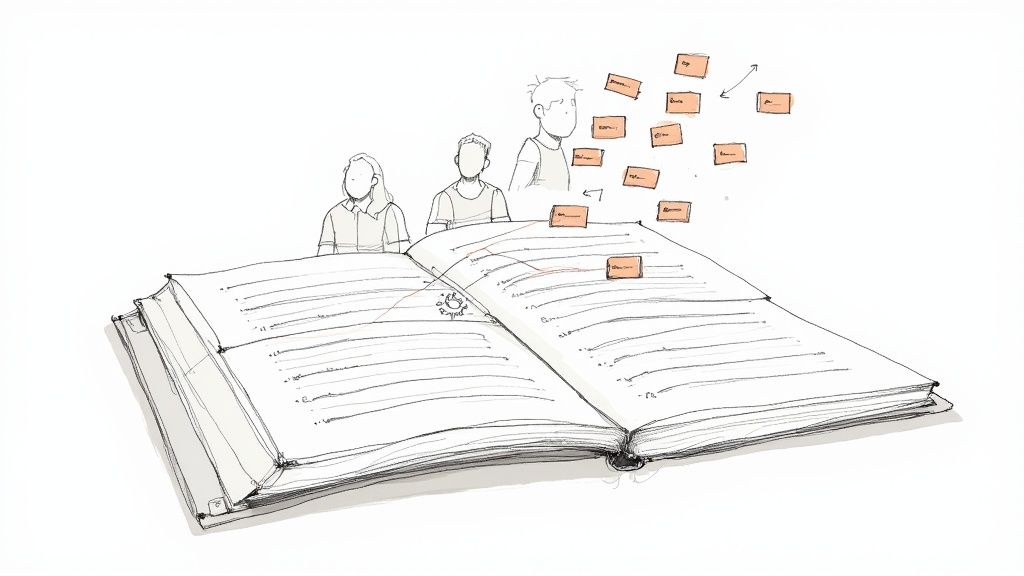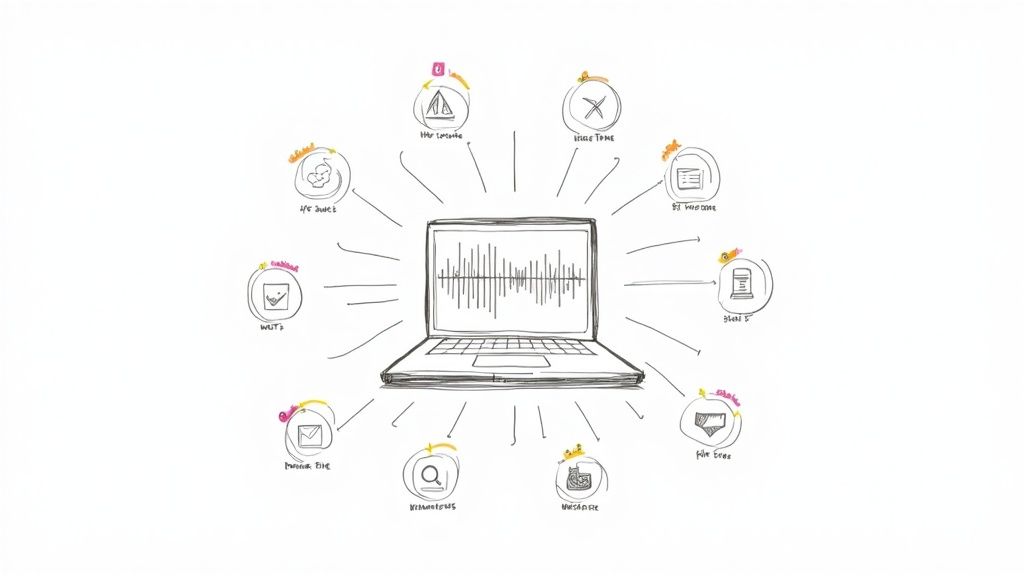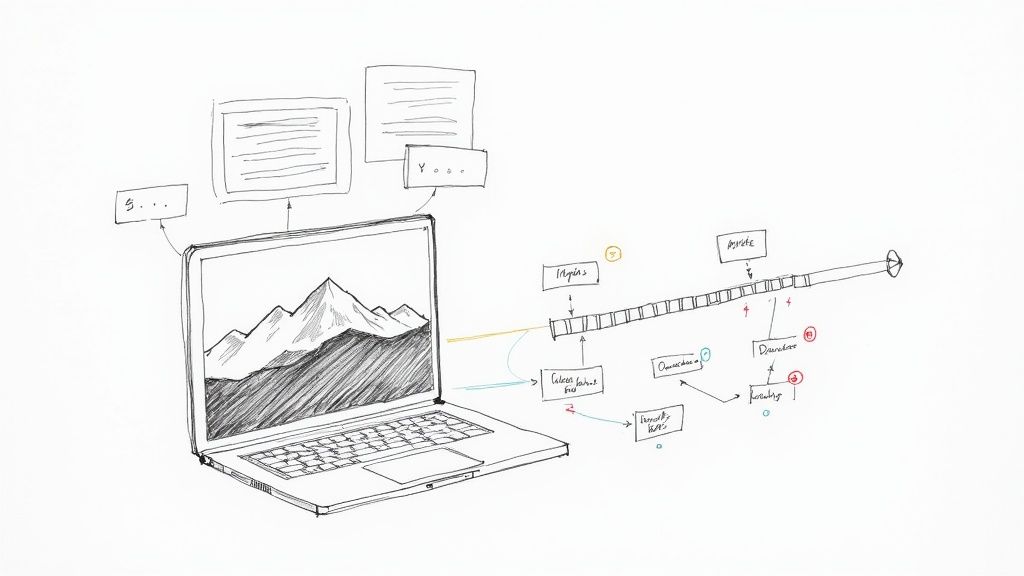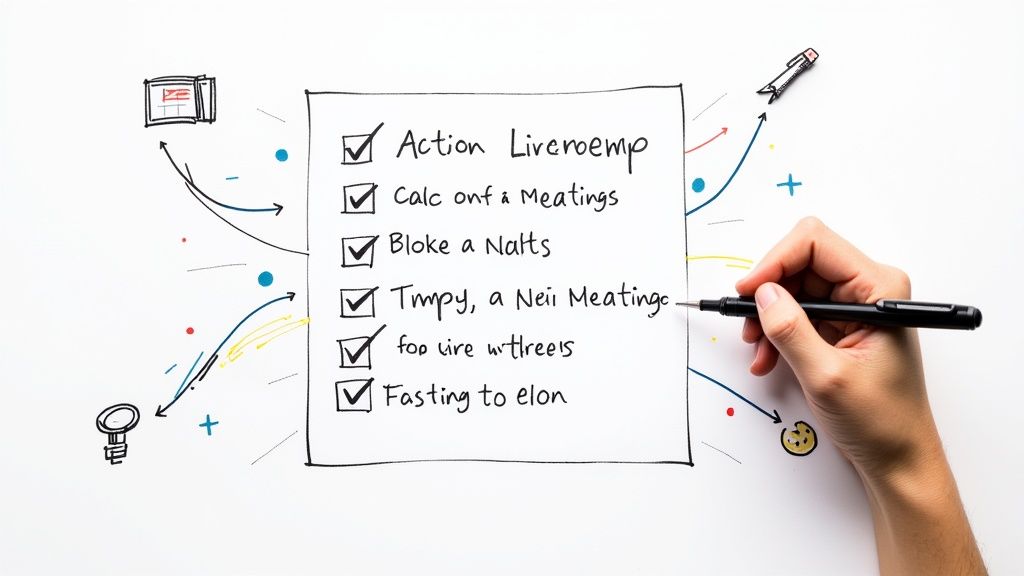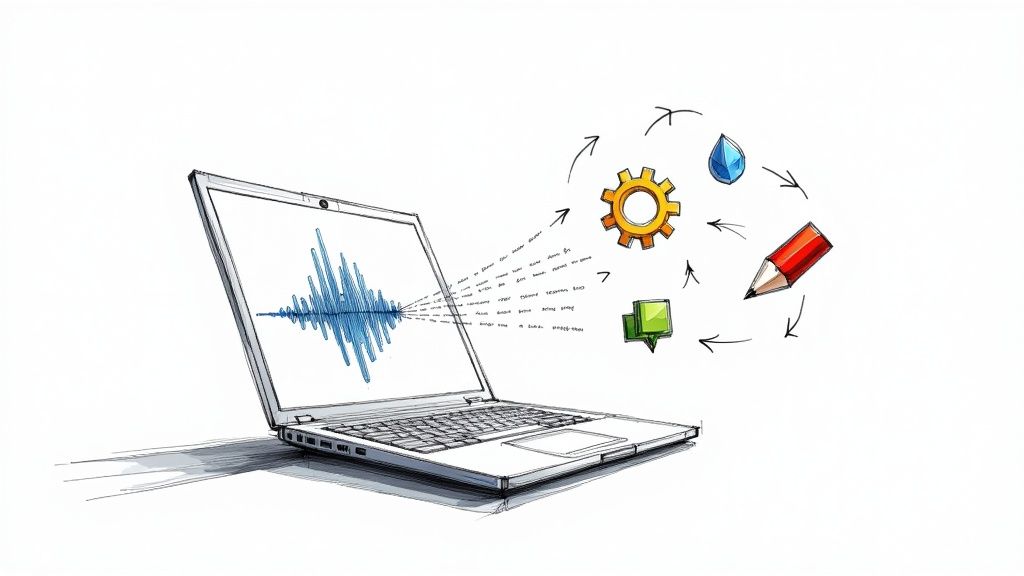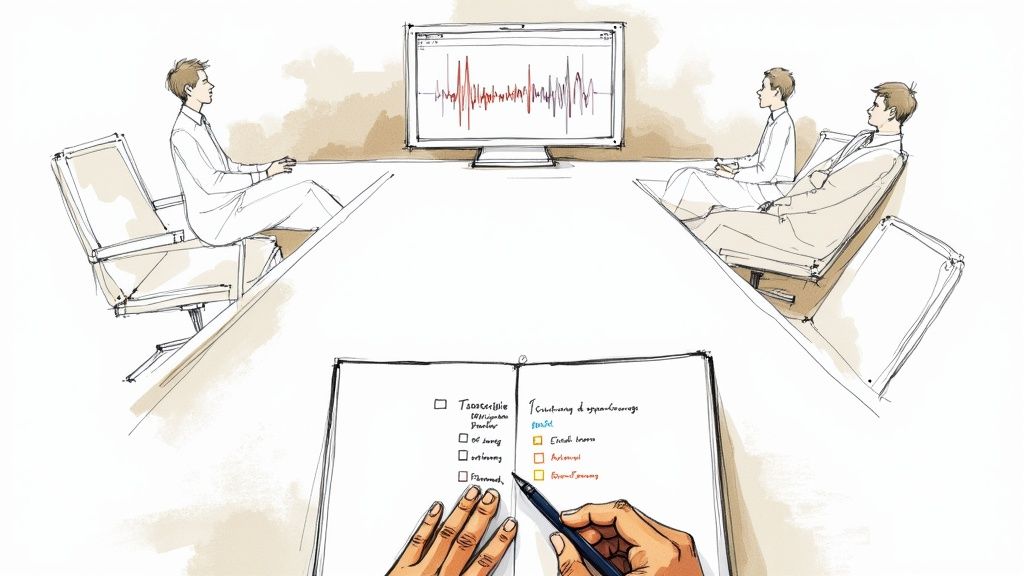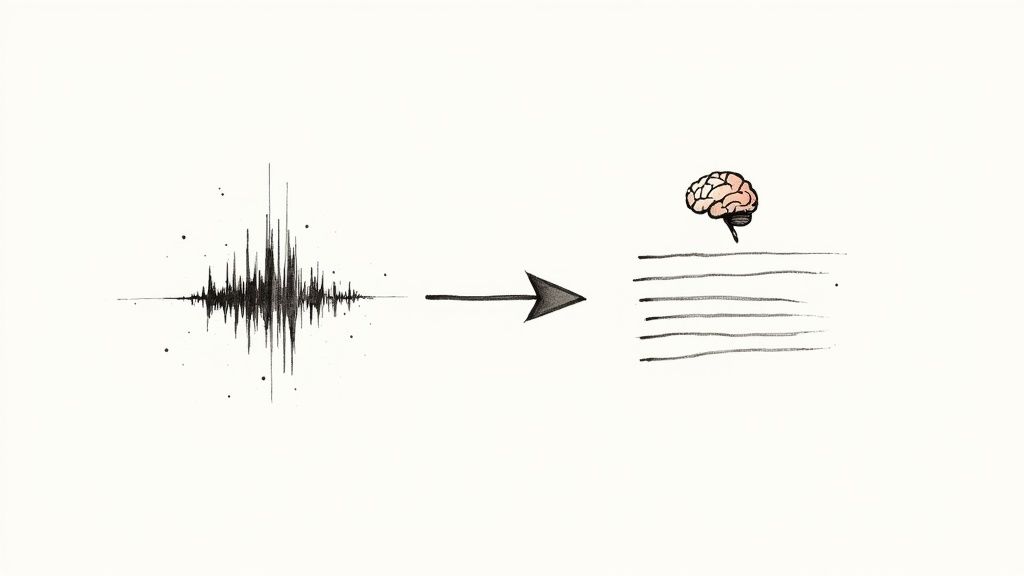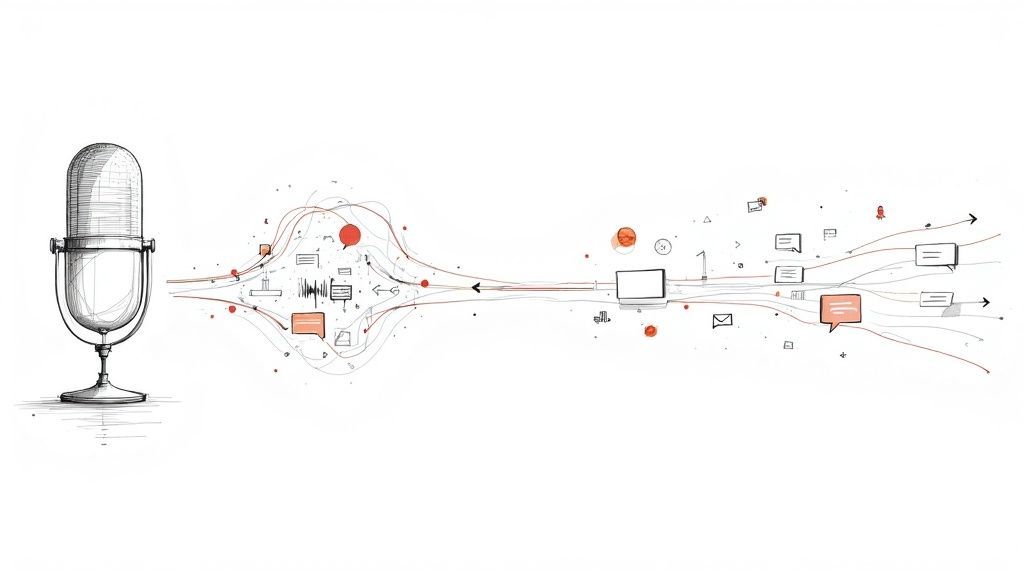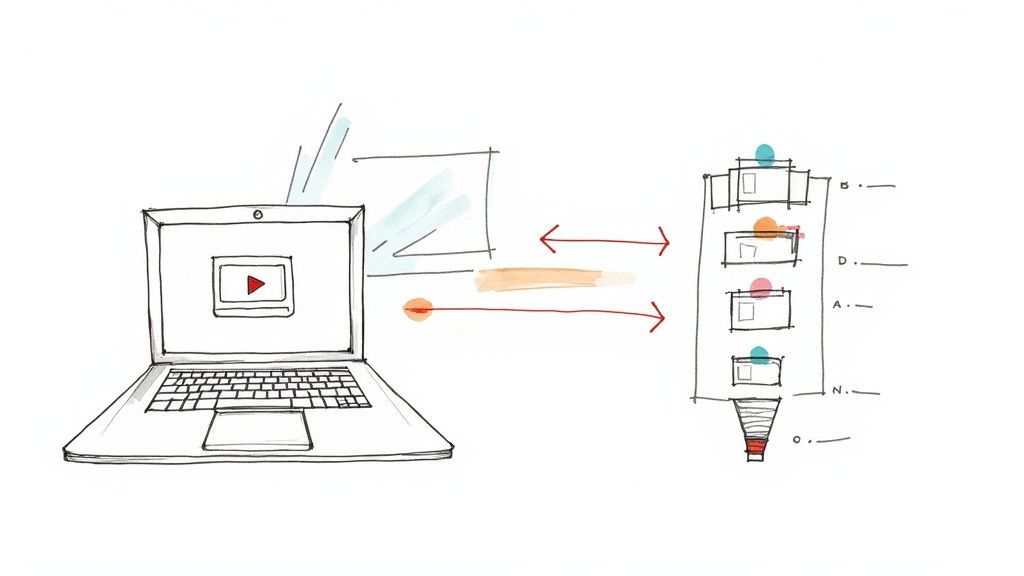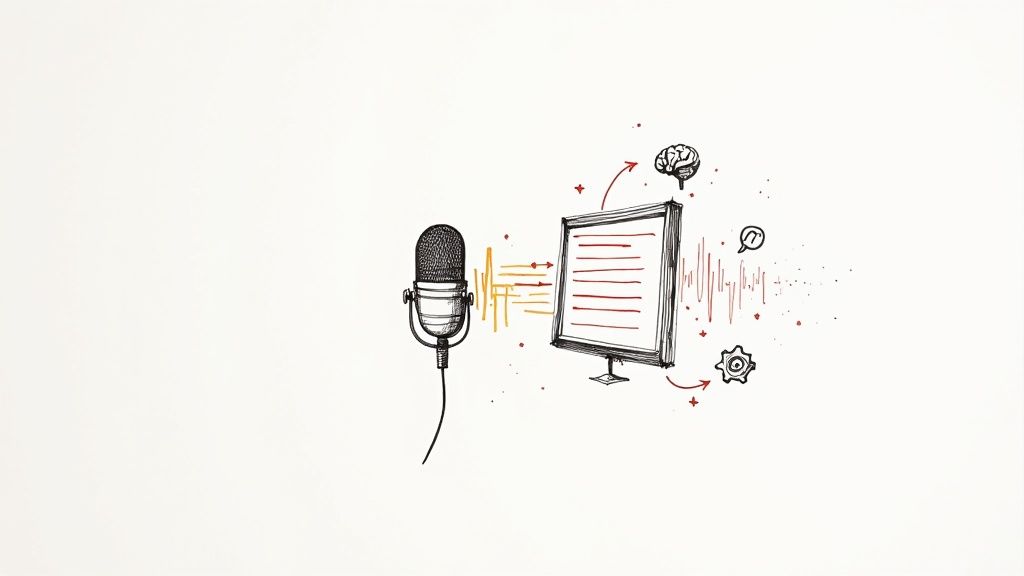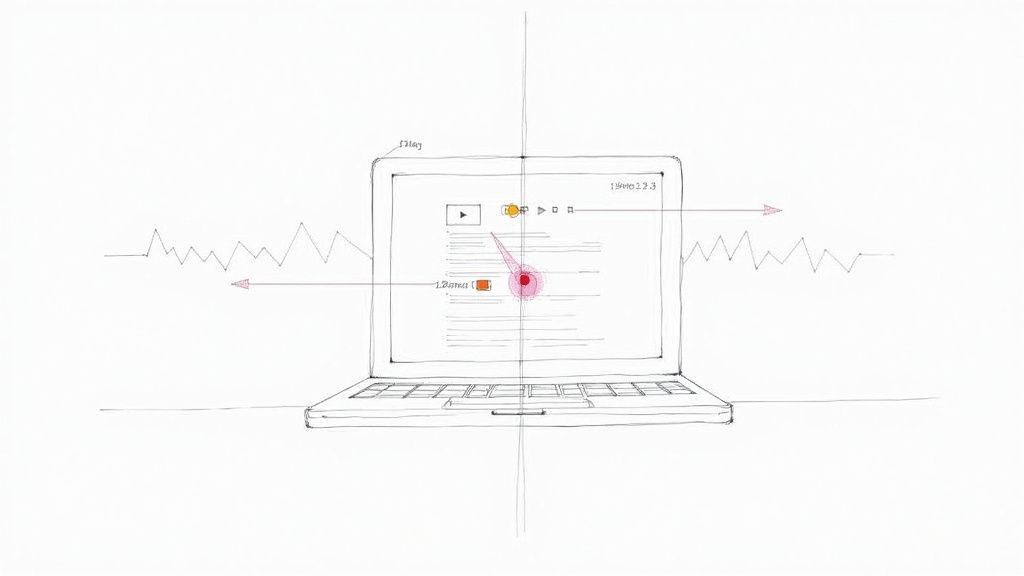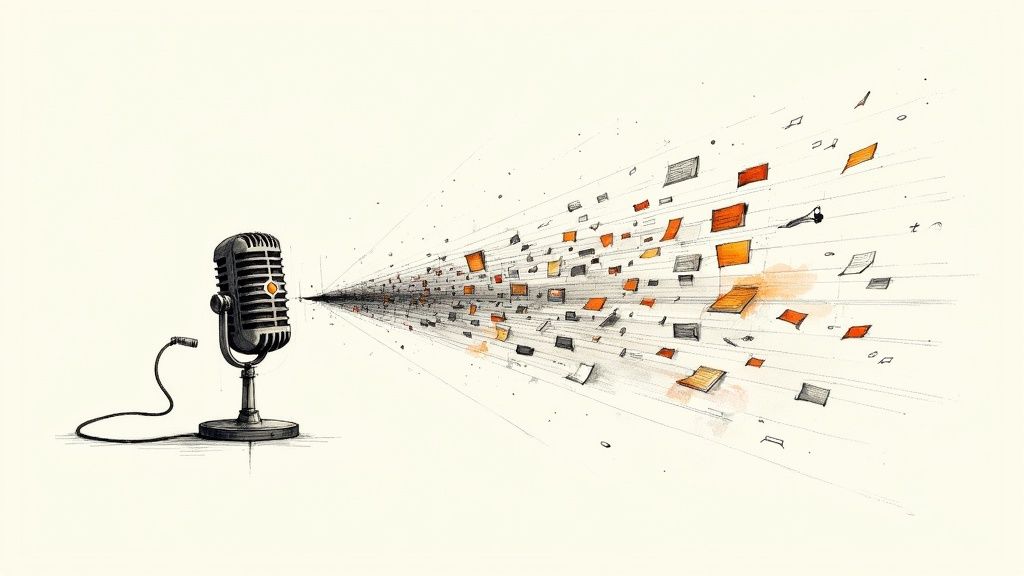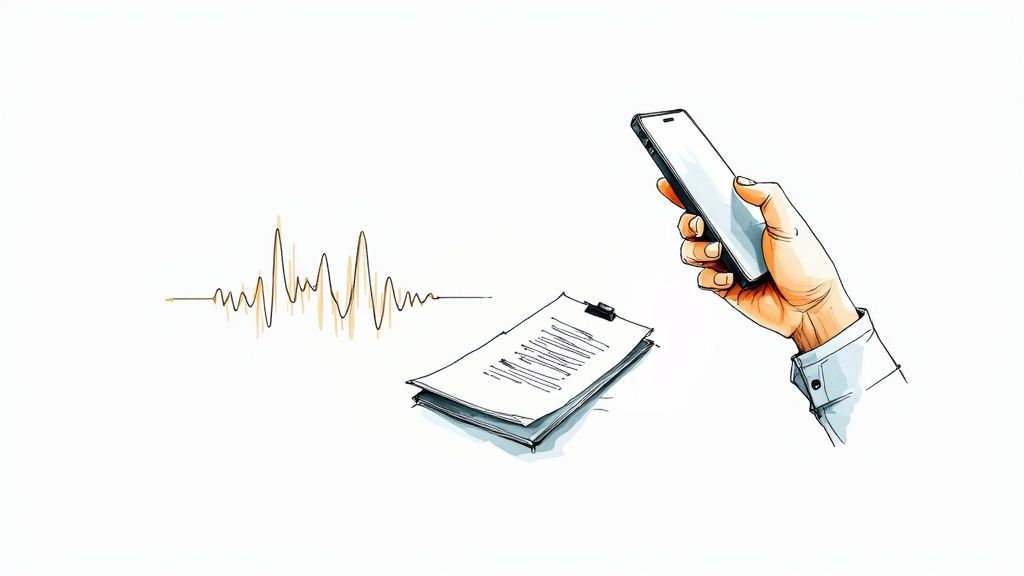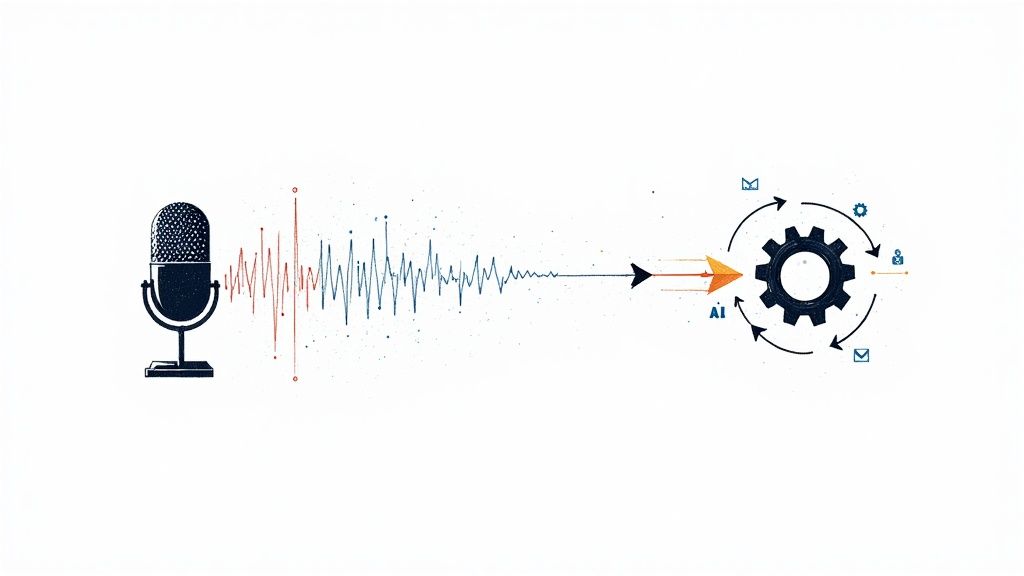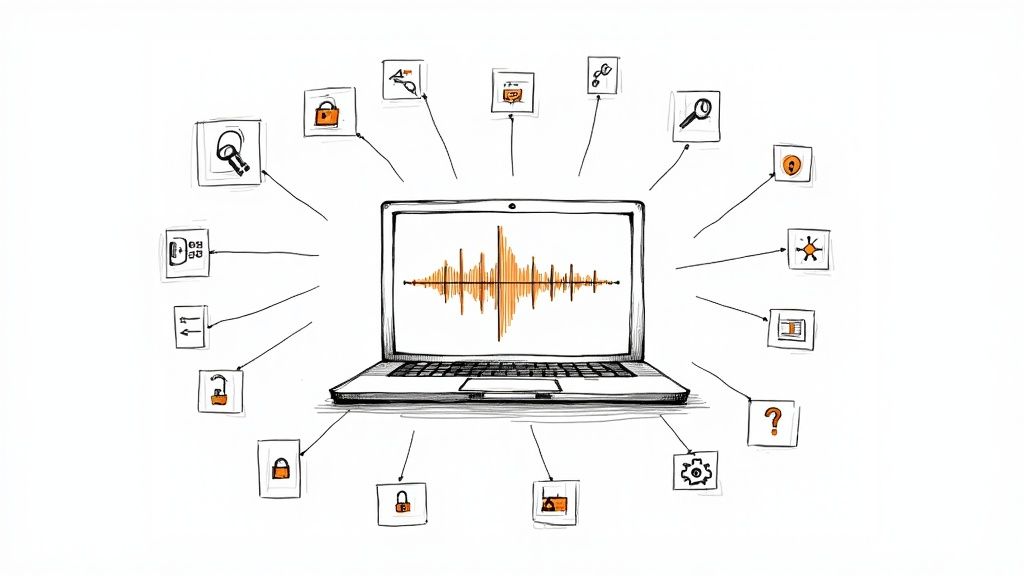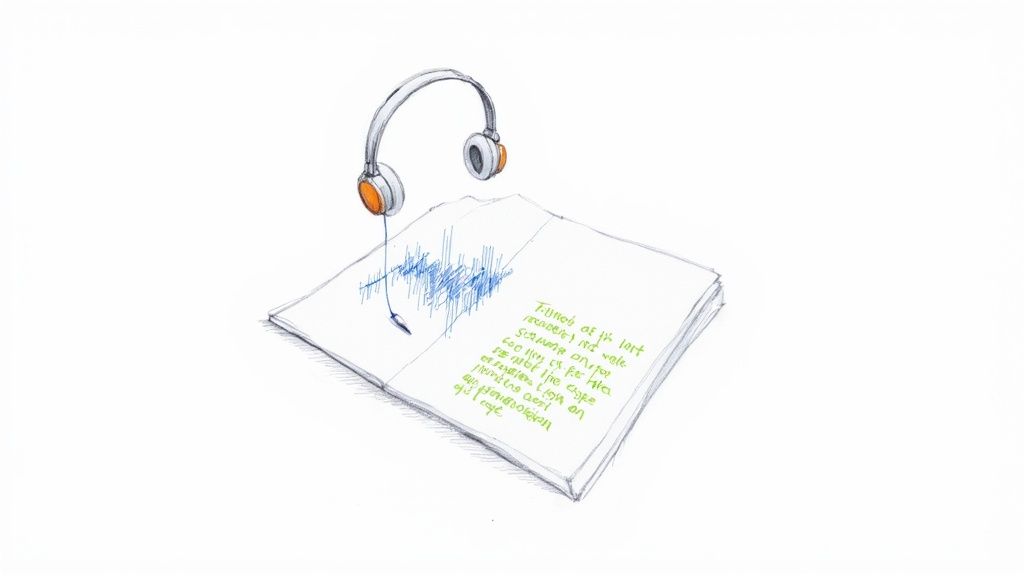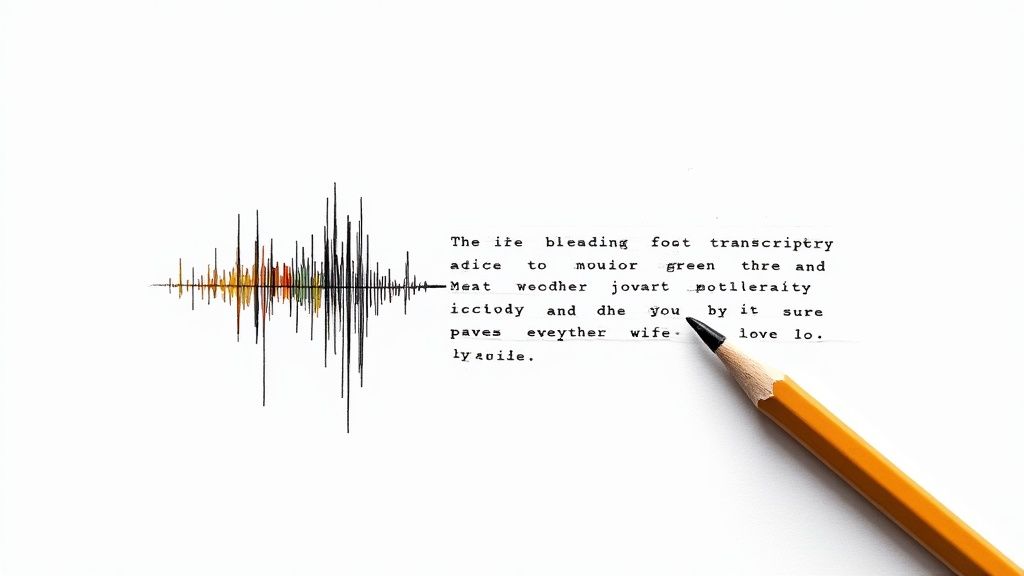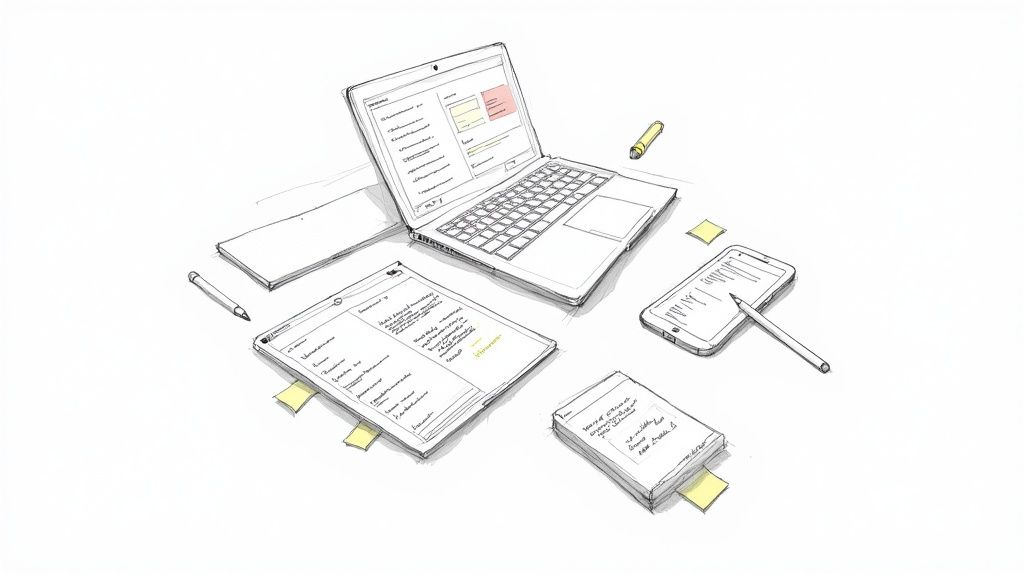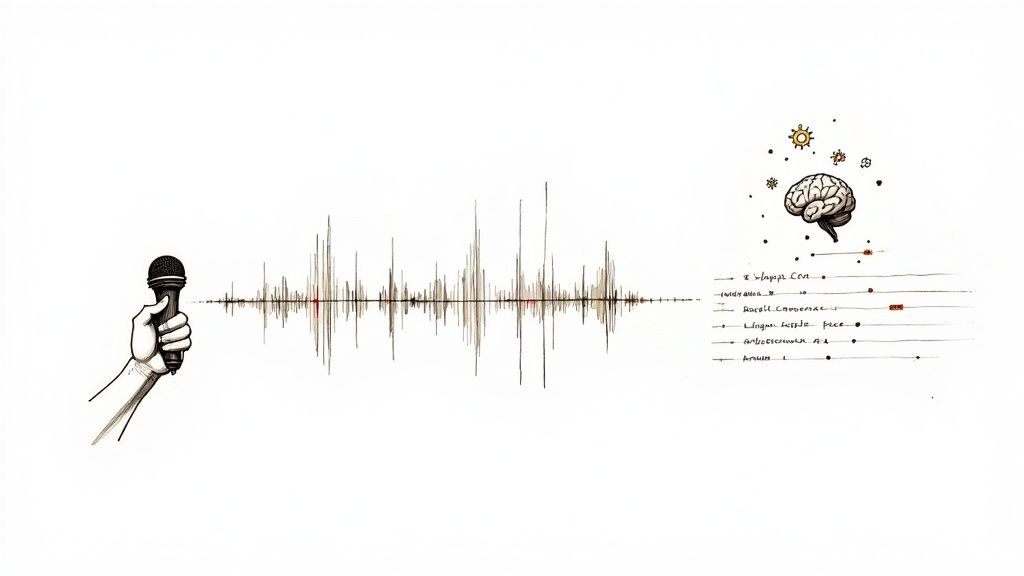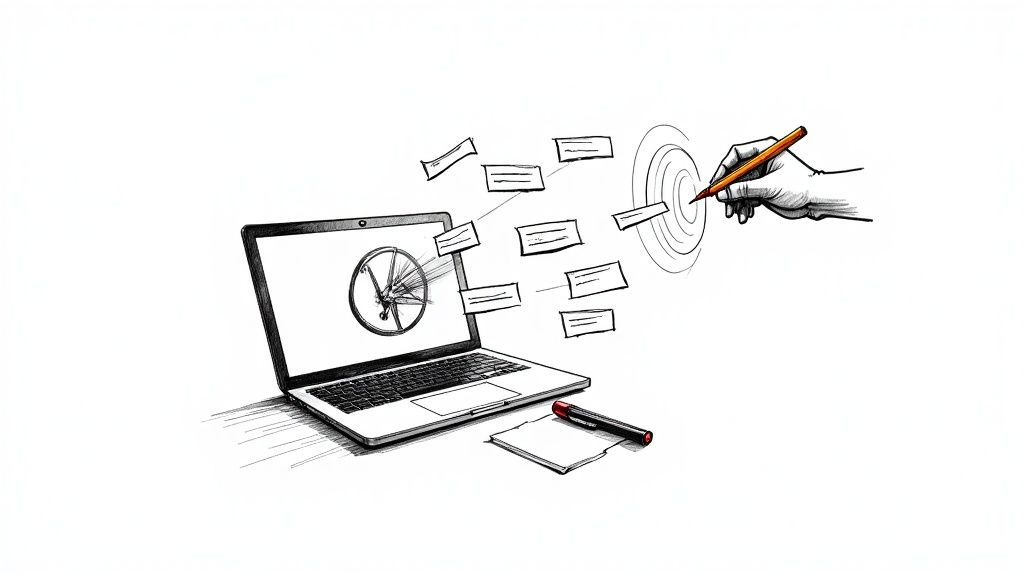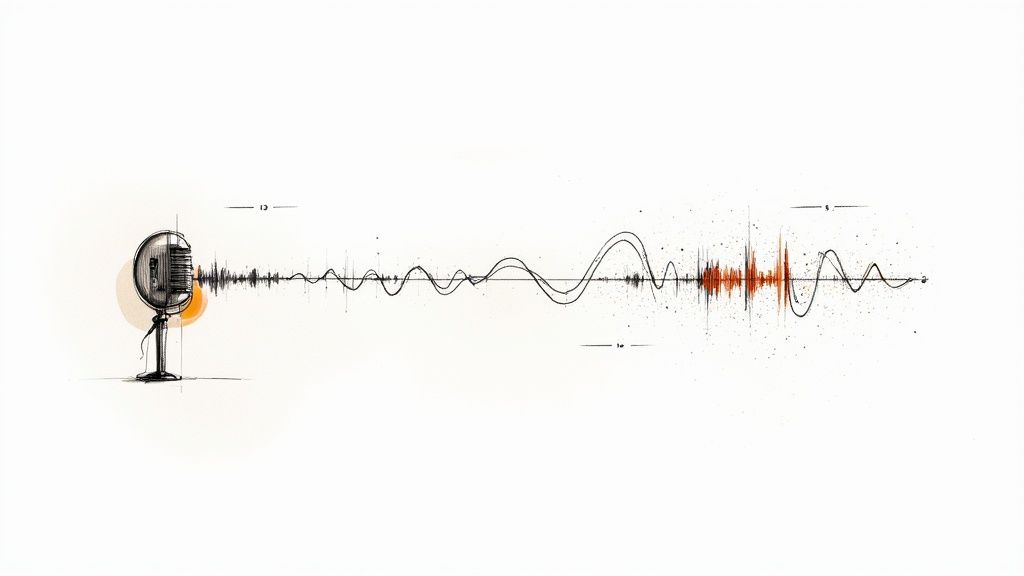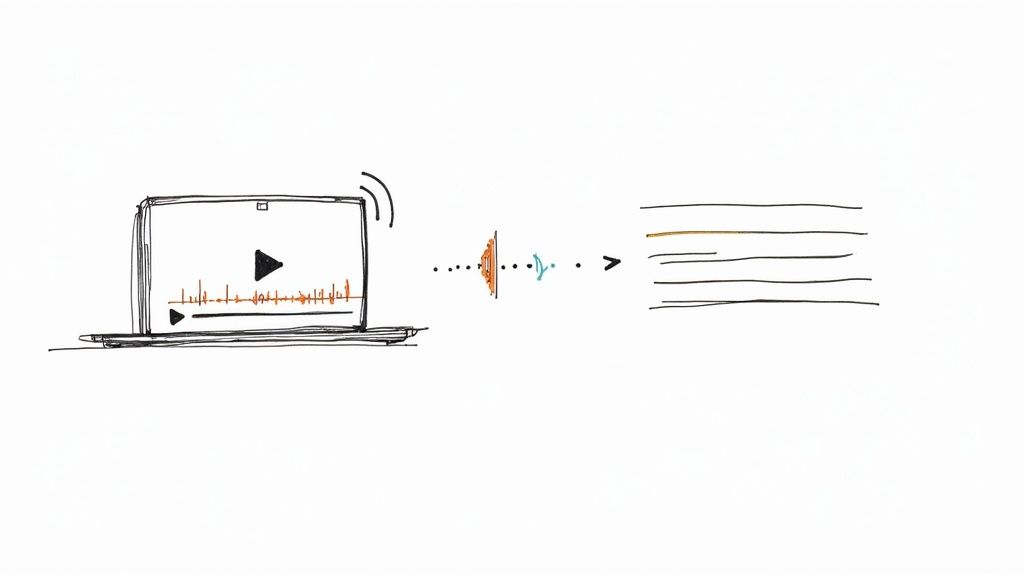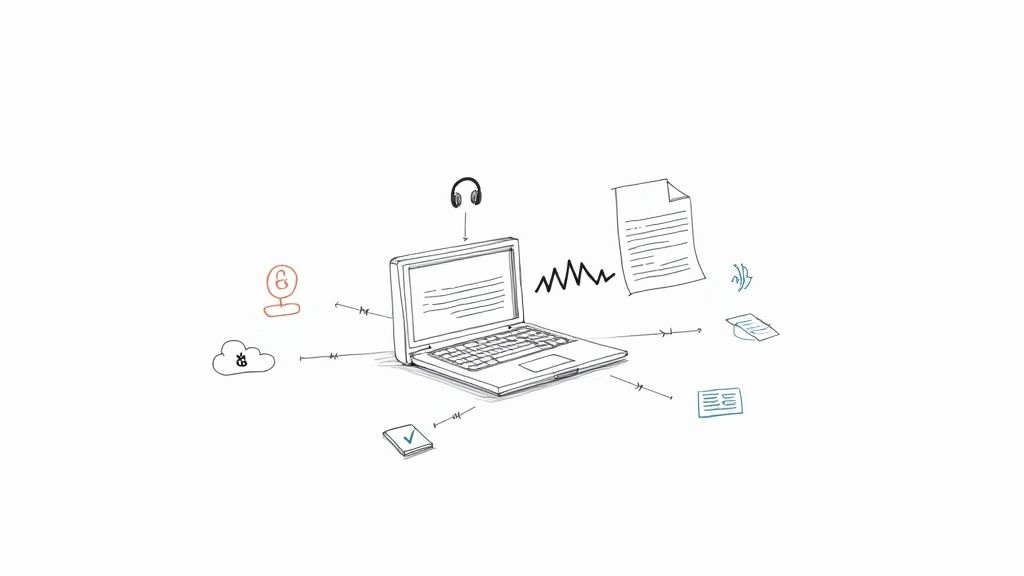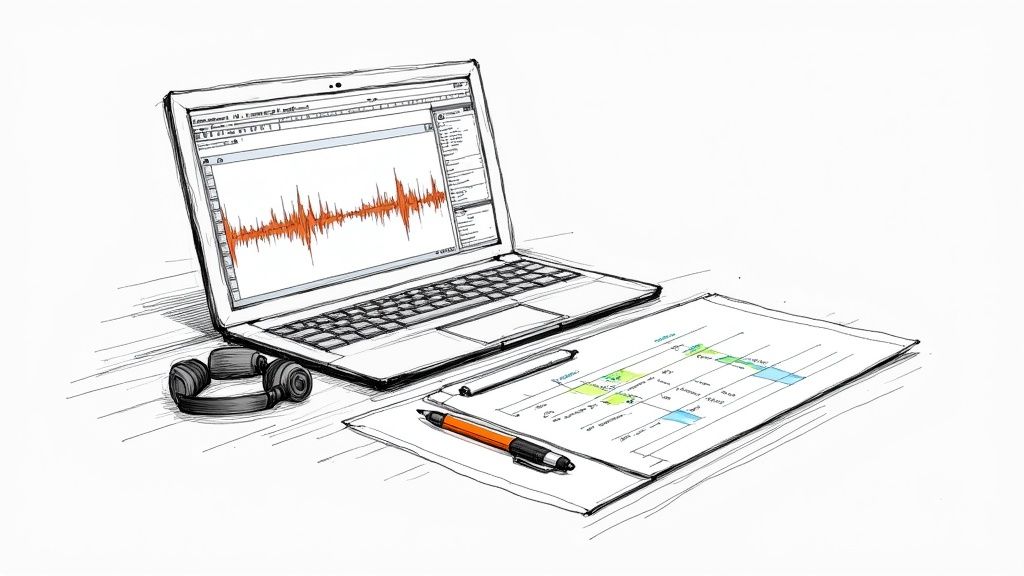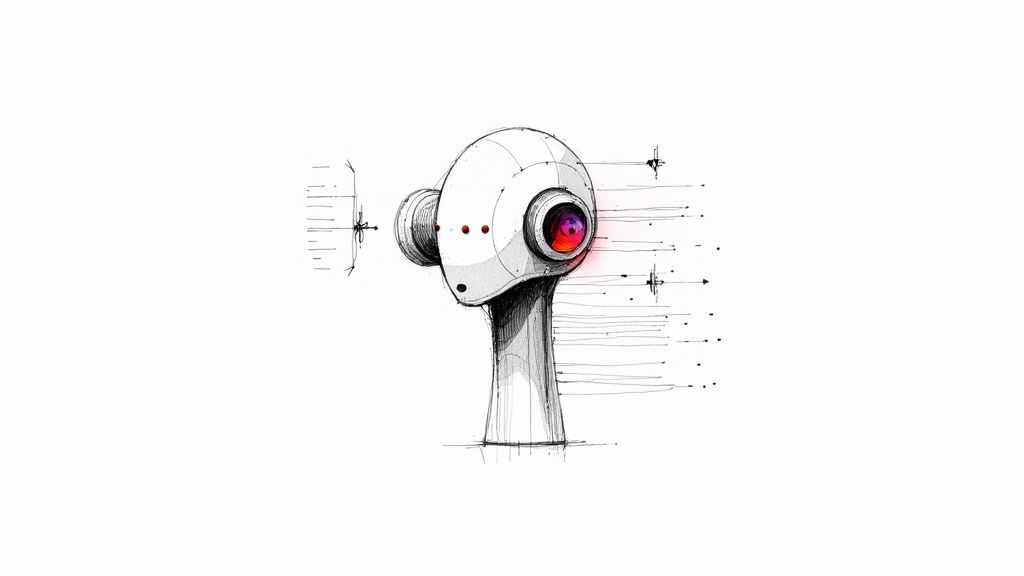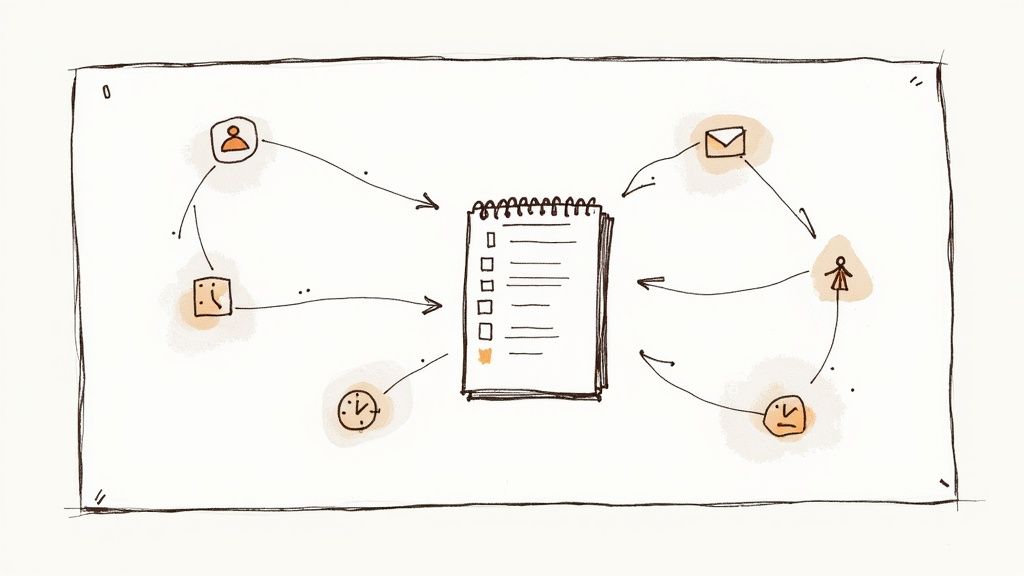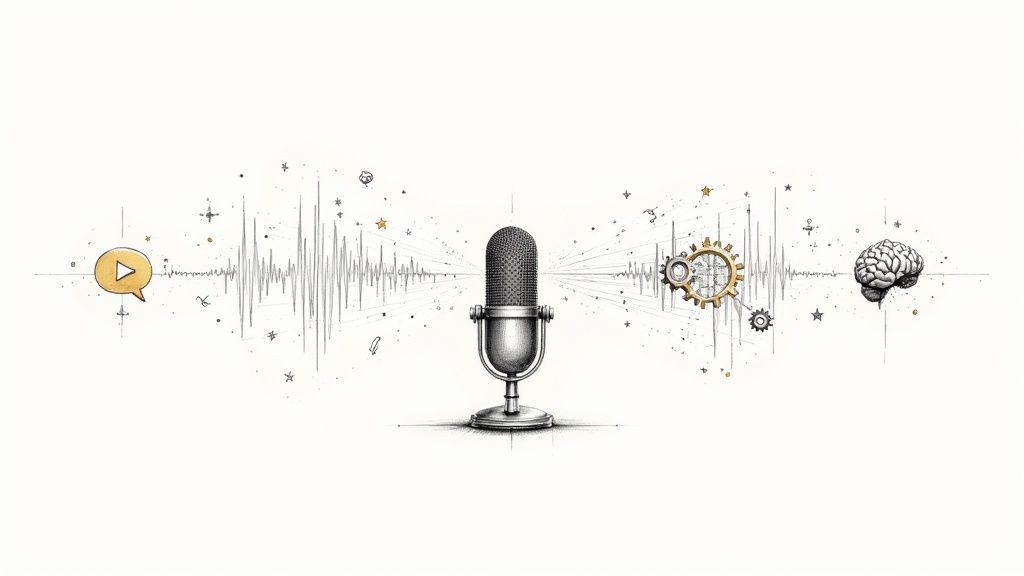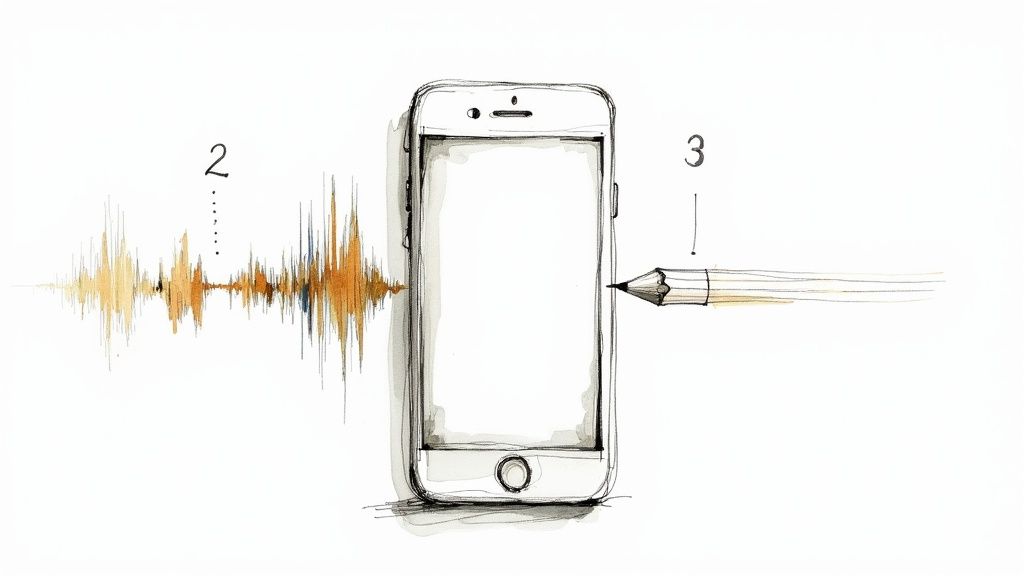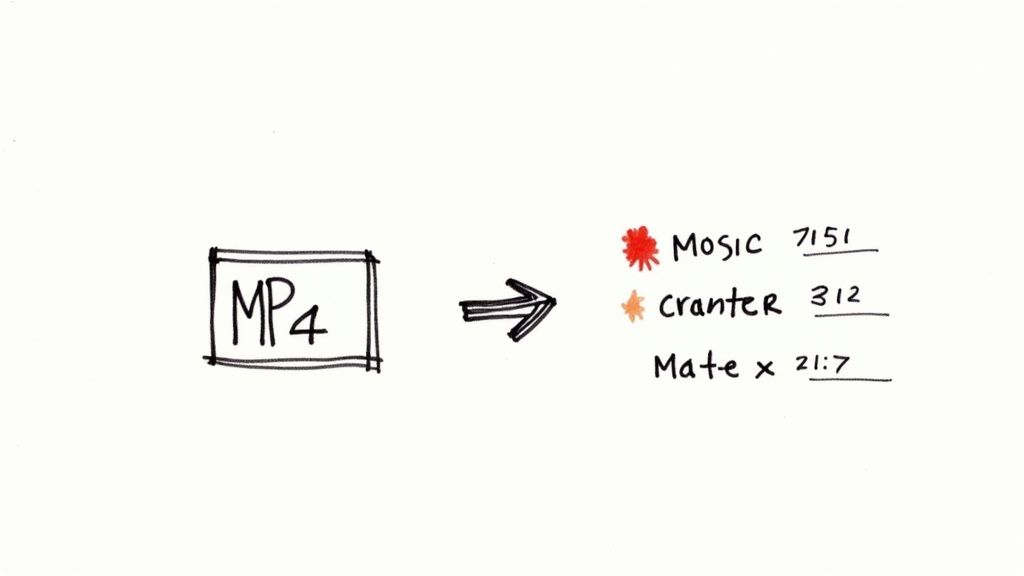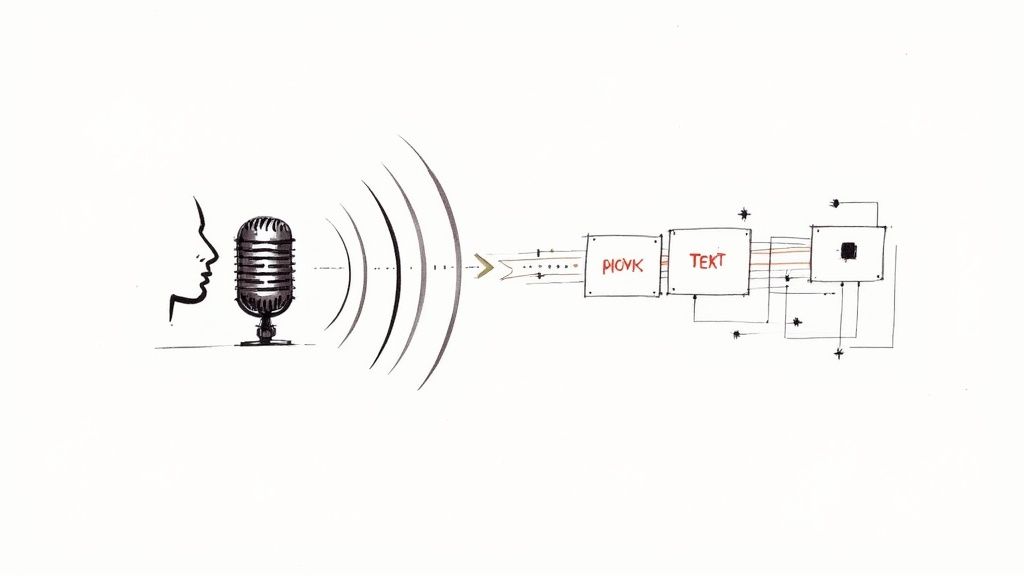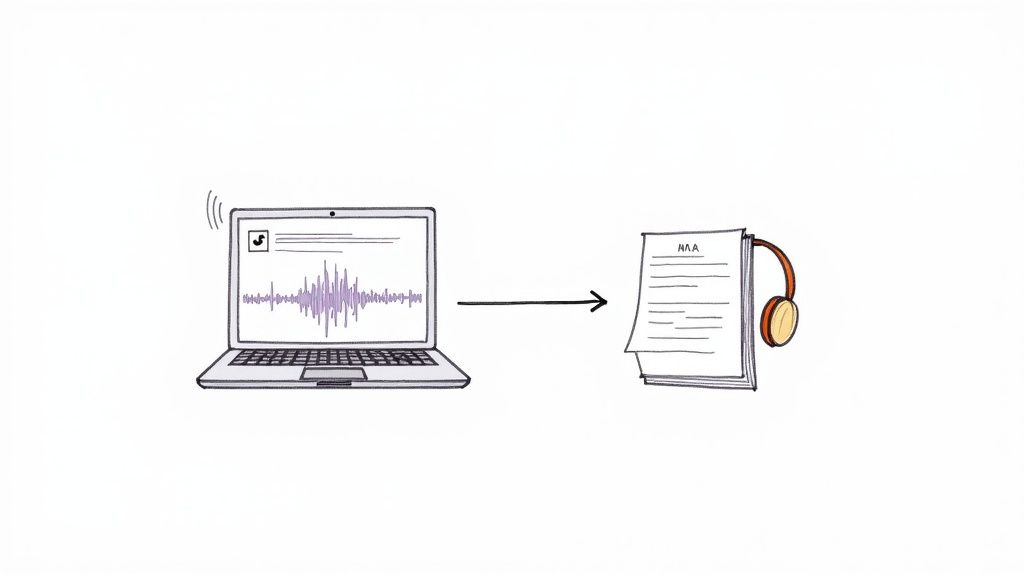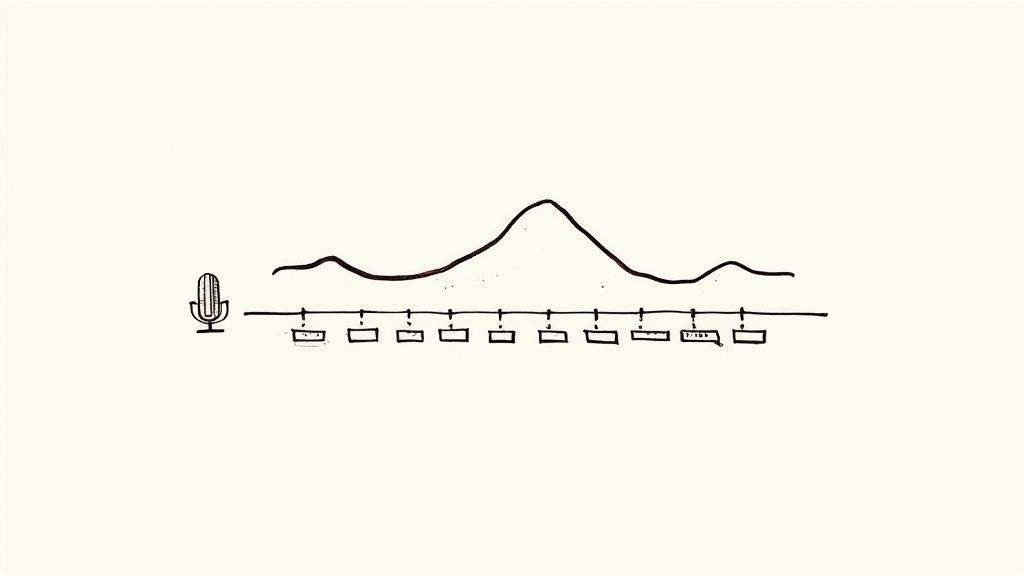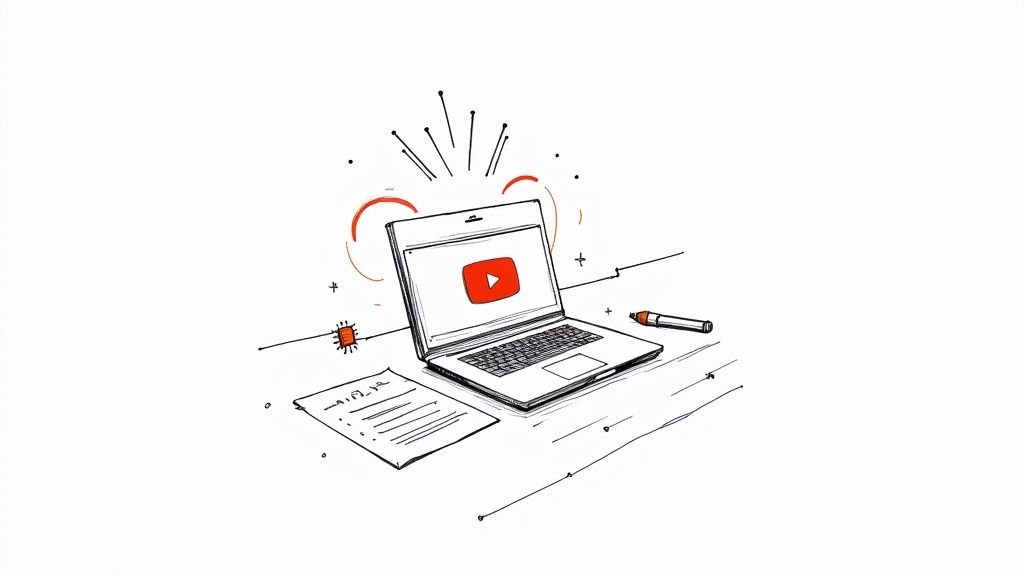
How Voice to Text AI Actually Works: A Practical Guide
At its core, voice to text AI is technology that translates spoken words into written text. I like to think of it as a super-powered digital stenographer that listens to audio and transcribes everything it hears. Once your speech is in text format, the information can be easily searched, edited, and shared.
From Sound Waves to Digital Text
Have you ever marveled at how your phone or smart speaker just gets what you're saying? That's voice to text AI in action. The technology works like a lightning-fast translator, but instead of translating between languages, it translates sound waves into text.
From my experience, this is a practical tool that's already changing how we work with our devices and manage information. The systems behind it are trained to pick out human speech from a sea of background noise, ensuring it captures the message you actually intended to share. This ability is quickly becoming essential for everything from simple communication to complex business workflows.
The Voice-First Shift is Here
More and more, we're choosing to talk to our devices instead of typing. This isn't just a passing fad—it's a real shift in how we interact with technology, and it's fueling an explosion in demand for accurate, reliable transcription.
The market numbers tell the story.
The global Voice AI market is projected to skyrocket from USD 3.14 billion in 2024 to an incredible USD 47.5 billion by 2034. This isn't just a small jump; it’s driven by everyone from consumers chatting with their voice assistants to large companies building voice into their core operations.
This isn't just about future projections, either. The change is happening right now. A solid 60% of smartphone users are already regularly using voice assistants, showing just how much we prefer hands-free, voice-first interaction. You can dig deeper into these market trends and their implications for future technology.
Why Understanding This Technology Matters
Getting a handle on voice to text AI is more important than ever because it’s no longer some niche, futuristic concept. It’s now a fundamental part of the tools we use every day to be more productive and make information more accessible.
Whether you're recording personal notes, transcribing business meetings, or creating content, understanding how this technology works will help you choose the right tools and get the most out of them. This basic knowledge sets the stage for everything else we're about to cover.
How AI Learns to Understand Your Voice
Ever wonder what’s happening in that split second between when you speak and your words appear on the screen? It's not magic. It's a lightning-fast, sophisticated process where a voice to text AI acts like a highly trained digital linguist, deciphering your speech almost instantly.
The whole thing starts with a microphone—the AI's ear. It captures the sound waves your voice creates and immediately converts those analog signals into a digital format. I find it helpful to think of this digital audio file as the raw clay an artist starts with before sculpting a masterpiece.
Breaking Down Sound into Meaning
Once your voice is digitized, the system's core engine, known as an Automatic Speech Recognition (ASR) model, jumps into action. Its first job is to dissect the complex audio into its tiniest phonetic parts, called phonemes. These are the fundamental building blocks of speech—the individual "c," "a," and "t" sounds that come together to form the word "cat."
To get this good, the AI has been trained on massive datasets filled with thousands upon thousands of hours of human speech. This isn't just one type of voice; it's a huge collection of different languages, accents, and speaking styles. This deep training enables its neural networks (algorithms inspired by the human brain) to spot patterns and accurately match the phonemes it detects to the most likely words in its vocabulary.
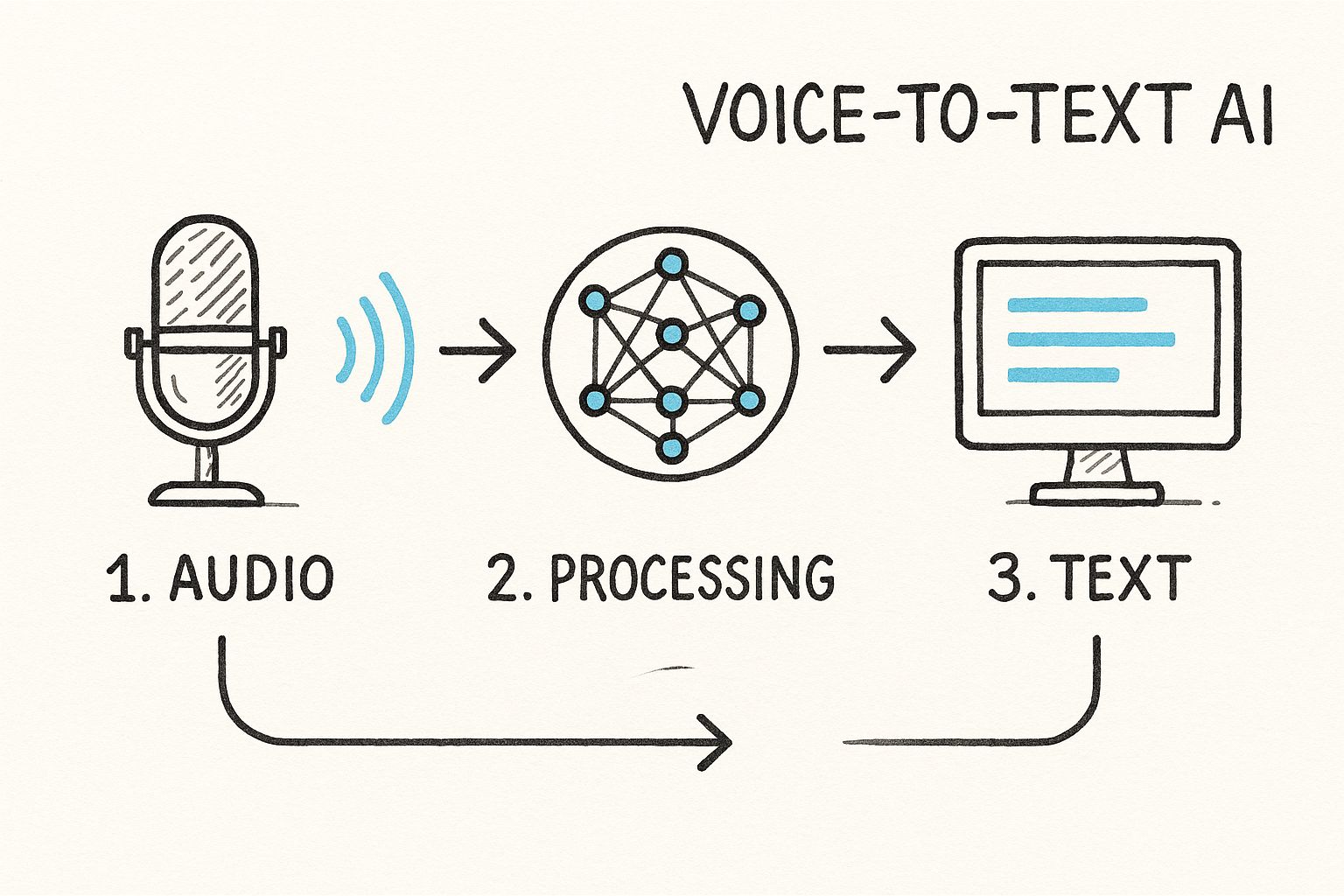
As you can see, the journey from raw sound to clean text is a multi-stage process, flowing from simple audio capture to complex AI analysis.
Adding Context and Grammar
But just recognizing words isn't enough. Without context, a transcription can go hilariously or horribly wrong. A simple ASR might spit out "let's eat grandma" when you actually said "let's eat, grandma." Punctuation saves lives! This is where the next layer of smarts, Natural Language Processing (NLP), steps in.
NLP algorithms look at the whole sequence of transcribed words to figure out grammar, syntax, and the overall context. They’re the editors of the operation, responsible for:
- Adding Punctuation: Intelligently placing commas, periods, and question marks to create clear, readable sentences.
- Correcting Grammar: Ensuring the final text follows proper sentence structure.
- Understanding Ambiguity: Figuring out the difference between words that sound alike but mean different things (like "their," "there," and "they're").
The real goal isn't just to write down words; it's to capture what you meant. By combining the "hearing" power of ASR with the "understanding" of NLP, the AI makes the leap from sound to language. That's the secret to getting a truly accurate and useful transcription.
This two-part system—acoustic models for sound and language models for context—is what allows a modern voice to text AI to deliver results with such impressive precision. It's a sophisticated collaboration that turns your fleeting spoken thoughts into permanent, structured text in the blink of an eye.
Putting Voice to Text AI to Work
Knowing how voice to text AI works is one thing, but seeing what it can do is where things get really interesting. From my experience, this isn't just about convenience; it's a genuine engine for efficiency and accessibility that's changing how entire industries operate by turning spoken words into actionable data.
The applications are popping up everywhere you look. Journalists, for instance, can now transcribe hours of interview audio in just a few minutes. Instead of being bogged down with manual typing, they can jump right into the heart of the story, letting them report news faster and more accurately.
In healthcare, it's a similar story. Doctors and nurses are using voice recognition to dictate patient notes on the fly, completely hands-free. This simple shift means more face-to-face time with patients and less time wrestling with paperwork—a huge win for both quality of care and reducing professional burnout.
Unlocking Value Across Industries
But the impact goes well beyond individual productivity. Companies are now feeding thousands of customer service calls into these systems to analyze sentiment, spot recurring issues, and find ways to improve their products. By converting all that voice data into searchable text, they can finally get a clear picture of what their customers are actually saying.
This kind of innovation is driving some serious economic growth. The AI speech-to-text market was valued at a whopping USD 3.82 billion in 2024 and is expected to explode to USD 29.45 billion by 2034. A huge chunk of that adoption is happening in key sectors, with healthcare alone accounting for 29% of the market as it races to improve clinical documentation. You can dive deeper into this booming market on Market Research Future.
At its core, the benefit is simple but profound: voice to text AI saves an incredible amount of time, slashes human error, and pulls out valuable insights that were once locked away in audio files.
Content creators are also seeing massive benefits. Podcasters and YouTubers can generate instant transcripts for their episodes, which is fantastic for SEO and makes their content accessible to audiences who are deaf or hard of hearing. They can even learn how to master MP4 to text transcription to easily turn video content into blog posts or social media captions.
Voice to Text AI Applications Across Industries
To really grasp how versatile this technology is, it helps to see how different fields are using it to tackle their unique challenges. The table below breaks down a few key examples.
IndustryPrimary Use CaseKey BenefitMedia & JournalismTranscribing interviews and press conferencesDrastically reduces turnaround time for content creation and ensures quote accuracy.HealthcareClinical documentation and medical notesFrees up medical professionals to focus on patient care rather than administrative tasks.Customer ServiceAnalyzing support calls for sentiment and trendsProvides actionable insights to improve customer satisfaction and operational efficiency.EducationCreating accessible notes from lecturesHelps students with different learning needs and creates a searchable archive of course material.
Each of these examples points to the same fundamental shift. Spoken language is no longer fleeting or difficult to parse. With the right AI tools, it becomes a rich, structured, and searchable asset, ready to be put to work.
How to Choose the Right AI Transcription Tool
With a sea of options out there, picking the right voice to text AI can feel overwhelming. I've found the secret is to ignore the noise and zero in on what you actually need to accomplish. The perfect tool for a developer building an app is rarely the right fit for a student trying to transcribe a lecture.
Think of it like choosing a car. You wouldn't buy a two-seater sports car for a family of five, right? The same logic applies here. A journalist on a tight deadline needs a tool that transcribes in real-time. A podcaster, on the other hand, needs something that can flawlessly distinguish between multiple speakers over a two-hour conversation. They're both "cars," but they're built for entirely different journeys.
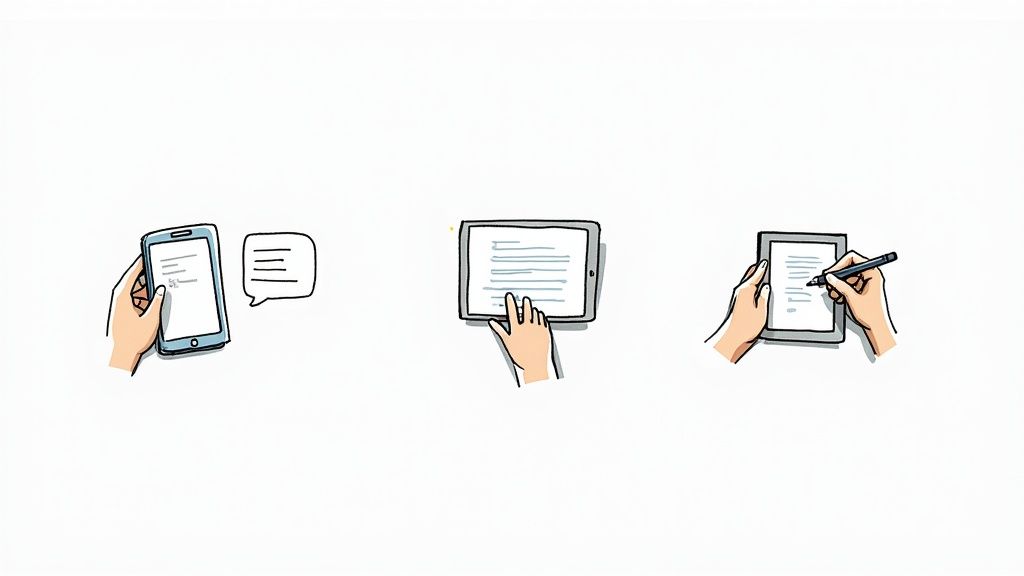
Start With Your Primary Goal
Before you even glance at a pricing page, ask yourself a simple question: "What problem am I actually trying to solve?" Your answer is the compass that will point you in the right direction, instantly filtering out the options that won't work for you.
For instance, if you're a business that needs to analyze customer service calls, you'll need top-tier accuracy, especially with your industry's specific terminology. But if you're a student recording a lecture, your priorities are probably an easy-to-use interface and a price that won't break the bank.
And if your goal is to repurpose video content into blog posts or articles, you’ll want a tool that shines at handling video files. For anyone working with online videos, we have a helpful guide on how to transcribe YouTube videos with AI that walks you through the process.
Key Features To Compare
Once your goal is crystal clear, you can start weighing your options based on a few critical factors. While accuracy is the baseline for any decent tool, other features can make or break the entire experience, depending on what you’re doing.
The best tool isn't the one with the longest feature list. It's the one with the right features for your workflow. A simple, accurate tool that saves you hours is infinitely better than a complicated one you never touch.
Here's a breakdown of what to keep an eye on when you're comparing tools.
Feature Comparison for Voice to Text AI Tools
Choosing a tool is all about matching its strengths to your specific needs. This table breaks down the most important features to help you decide what matters most for your situation.
FeatureWhy It MattersIdeal ForTranscription AccuracyThis is the bedrock. Low accuracy just creates more editing work for you, which completely defeats the purpose of using an AI in the first place.Everyone, but it's absolutely non-negotiable for legal, medical, and journalism professionals where every word counts.Language & Accent SupportIf the AI wasn't trained on diverse voices, it will stumble over different accents, dialects, and languages. Good support is a must for global use.Global teams, content creators with an international audience, and researchers working with diverse groups of speakers.API AccessAn API (Application Programming Interface) lets you plug the transcription service directly into your own software, building it into your workflows.Developers and businesses who want to create custom voice-powered apps or automate their internal processes.Security & PrivacyWhen you're dealing with sensitive information—like patient records or confidential meetings—you need ironclad assurance that your data is safe.Healthcare organizations, law firms, enterprise clients, and anyone who handles confidential information.Real-Time ProcessingSome tools can generate text as someone is speaking, giving you a live feed. This is essential for any application that needs immediate results.Live event captioning, real-time agent support in call centers, and accessibility tools for the deaf and hard of hearing.
By thinking through your goals and carefully weighing these features against your budget, you can move forward confidently. You'll be able to choose a voice to text AI solution that truly fits your needs, making a potentially confusing decision remarkably simple.
Getting Crystal Clear Transcriptions Every Time
The accuracy of any voice to text AI hangs on one simple thing: the quality of the audio you feed it. Think about trying to have a conversation in a loud, crowded restaurant—even a person with perfect hearing will struggle to catch every word. The AI is no different. Providing it with clean, clear audio is the single biggest key to success.
The good news? You don’t need a professional recording studio to see a massive improvement. A few small tweaks to your recording space and how you speak can make a world of difference. Your first step is to find a quiet spot. Shutting out background noise from traffic, humming air conditioners, or other people's conversations will instantly boost your results.
Another game-changer is using a decent external microphone instead of the one built into your laptop or phone. Even an affordable USB mic is designed to isolate your voice and capture it with far more clarity, cutting out a lot of the ambient fuzz.
Fine-Tuning Your Audio Input
Once you’ve sorted out your environment, it’s time to think about how you’re speaking. These AI models learn from vast libraries of clear speech, so when we mumble, talk too fast, or let our voices trail off, we’re throwing them a curveball.
It all comes down to giving the AI unambiguous audio data. The cleaner the signal you send in, the more precise the transcript you get back. It's the classic "garbage in, garbage out" situation.
To get the best possible results, try making these simple habits second nature:
- Speak Clearly and Deliberately: Take a breath and enunciate your words at a natural, steady pace. There's no need to speak slowly, just avoid rushing or whispering.
- Position Your Microphone Correctly: Keep the mic a consistent distance from your mouth—usually a few inches is perfect. This helps avoid the popping sounds from your breath and keeps the volume level even.
- Manage Multiple Speakers: If you're recording a meeting or an interview with several people, make a rule that only one person speaks at a time. Overlapping conversations are one of the toughest things for any transcription AI to untangle.
Advanced Techniques for Niche Accuracy
For professionals in fields like medicine, law, or engineering, just being clear isn't always enough. These industries are loaded with technical jargon, acronyms, and unique phrases that a general-purpose voice to text AI is bound to stumble over.
This is where more advanced features become incredibly valuable. Many top-tier services let you build a custom vocabulary. By uploading a list of your specific terms, product names, or industry-specific acronyms, you're essentially giving the AI a cheat sheet for your world. This is how you get an accurate "brachiocephalic trunk" instead of a confusing guess like "break you cephalic drunk."
Speaker identification is another must-have for any recording with more than one person. Tools that can tell different voices apart and label them in the transcript make the final document infinitely more readable and useful. Without it, you’re left with a wall of text and no idea who said what. Taking these extra steps can turn a pretty good transcription into a perfect one, especially when you learn how to get a clean transcription with timecode and speaker labels to streamline your work.
The Future of Voice and Human Interaction
As impressive as today's voice to text AI is, we're really just seeing the tip of the iceberg. The trajectory we're on points to a future where speaking becomes the most intuitive and primary way we interact with our devices, moving way past just simple dictation.
Think about it: an AI that doesn't just process your words but actually understands your tone of voice. New systems are being trained to pick up on emotional signals—like frustration in a customer's voice or excitement in a creative brief—directly from speech. This unlocks a whole new level of possibility for applications like more empathetic customer support bots or even mental wellness tools.
Beyond Transcription to True Communication
But the evolution doesn't stop there. We're on the cusp of real-time translation that happens during a conversation, effectively tearing down language barriers on live calls. This isn't just about swapping words from one language to another; it's about enabling real human connection.
This forward momentum is also happening on the other side of the equation: AI-generated speech. The market for AI voice generators is expected to explode, rocketing from USD 4.9 billion in 2024 to an incredible USD 54.5 billion by 2033. This surge is fueled by our growing appetite for more natural-sounding virtual assistants and easily accessible audio content. You can dive deeper into the growth of AI voice generation on Straits Research.
The end goal here is for the technology to just... disappear. Voice interaction is being seamlessly woven into the fabric of our lives—into smart glasses, car dashboards, and smart home devices—ready to help without you ever having to look at a screen.
When it's all said and done, the future of voice AI isn't about getting rid of keyboards. It’s about building a more natural, accessible, and deeply human way to connect with the technology that surrounds us.
Your Questions About Voice to Text AI, Answered
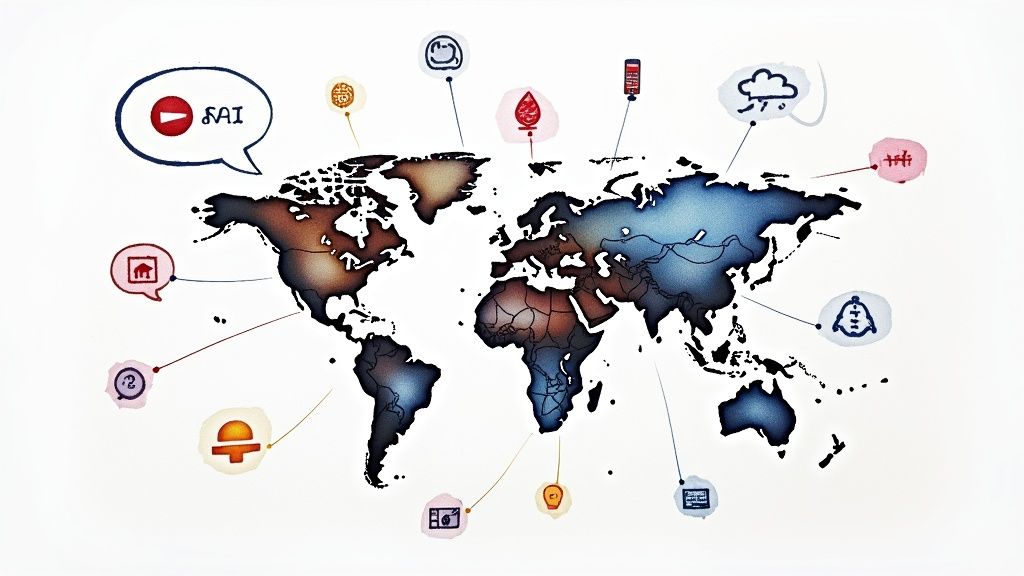
As you start digging into voice to text AI, it's natural for some practical questions to pop up. Let's get you some clear, straightforward answers to the most common ones.
How accurate is voice to text AI?
This is usually the first thing people ask, and for good reason. Under the right conditions, today's top AI transcription tools are incredibly accurate—we're talking over 95% accuracy.
What are the "right conditions"? Think clean audio, one person speaking clearly, and very little background noise. Where you'll see accuracy take a hit is with heavy accents, people talking over each other, or just plain bad audio quality. The better the sound you feed the AI, the better the text you'll get back.
Is my data safe when using these tools?
A very smart question. Reputable voice to text AI providers know that trust is everything, so they take security seriously. This usually means encrypting your files when you upload them and while they're being processed.
A non-negotiable rule of thumb: always choose a service with a crystal-clear privacy policy. It should explicitly state that they won’t use your data to train their models unless you give them permission. Before you upload anything sensitive, do a quick check on their security practices.
Many of the best services are also built to automatically delete your files right after the transcription is done, so your data isn't just sitting on their servers.
How much does voice to text AI cost?
Pricing is all over the map, but most services fall into one of three buckets:
- Pay-As-You-Go: You simply pay for what you use, usually by the minute or hour. This is perfect if you only need transcriptions every now and then for specific projects.
- Subscription Plans: You pay a flat monthly or yearly fee for a certain number of transcription hours. This model almost always gives you a better per-minute rate and makes sense for anyone with consistent needs, like podcasters, journalists, or researchers.
- Free Tiers: Most tools will let you kick the tires with a limited free plan. It’s the best way to test out the accuracy and see if the workflow feels right before you pull out your credit card.
The "best" option really just comes down to how much you'll be using it and what your budget looks like.
Ready to turn your audio and video into accurate text, summaries, and actionable insights? Join over 50,000 users who trust Whisper AI for fast, reliable transcriptions. Try it today and see how easy it can be.
